美国学生和中国学生的差异
中国和美国大学生活的差距

一美国大学生的作息和学习由于美国大学实行的是“完全的”学分制,一学期修哪些课程完全由学生自主决定,因此大学生没有整齐划一的作息时间,也绝没有熄灯制。
如果第二天早8点无课,那么愿起早还是睡懒觉完全是个人自由,学生宿舍通常不超过3人,及宿舍内的设施差别外,这方面跟国内大部分大学大学生的状况基本一致。
美国大学生的作息时间和作息制度跟中国大学存在很大差别,中国文化在作息时间上讲究的是规律,上课时间基本都是分上午;下午;晚上三个阶段,而且时间都很有规律。
另外中国大学里边的学生活动中心跟美国的也有差异,中国大学里的活动中心一般就是些体育设施或者干脆就是什么都没有以供学校举行活动用,不会出现如休息室、娱乐室之类的,更加不会有游戏厅。
这其中体现的就是中美文化对个人的态度,中国文化更注重集体主义,学校大部分设施主要以学校为,而美国文化里边则更加注重个人主义,他们更加注重个人的感受和生活质量。
二美国大学生看待学位证书的态度学位证书固然很重要,它是你受过并完成高等教育的重要标志。
大学里每年夏天举行的毕业典礼,是一年当中最隆重的庆典,典礼之后还要大宴宾朋,包括毕业生和他们的家长和亲属。
美国大学毕业生此时的心情大概与中国的高中生考上大学时相当,中国学生的关键是能否通过高考独木桥,考上大学;而美国大学宽进严出,关键却是能否大学毕业。
另一方面,美国是个讲求实际的国家,美国不少大学生、研究生,偶学位还未拿到,就已经在公司里上班,薪水当然是与其学位相当的。
美国社会既重视学位,更重视实际能力。
美国技术部门用人不仅看其成绩单优秀与否,还要看其是否学过某些重要的课程,同时给一技术问题令其在一两周内解决,最后还要判断其是否能和同事融洽相处。
但是,在一时难以分辨高下时,当然是以学历、特别是名牌大学的学历来决定取舍。
这也是可以理解的。
三美国大学生的恋爱态度美国是充分开放的社会,包括性开放。
美国青年谈恋爱较早,高中生即开始date(约会),据说高中毕业的女生中处女已经不多。
中美学生的差异
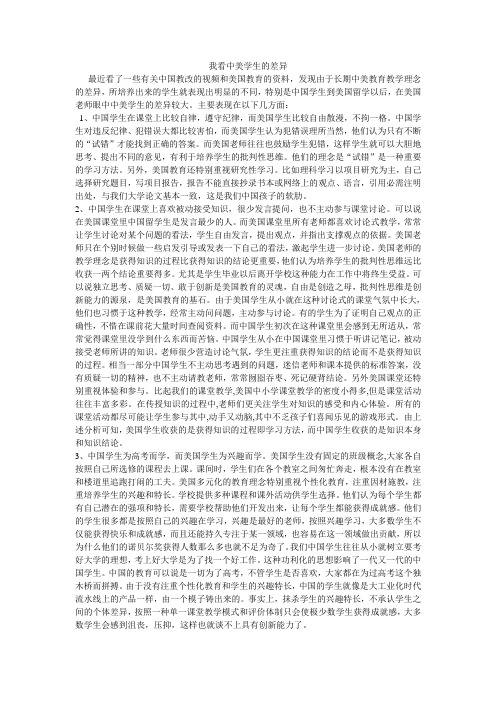
我看中美学生的差异最近看了一些有关中国教改的视频和美国教育的资料,发现由于长期中美教育教学理念的差异,所培养出来的学生就表现出明显的不同,特别是中国学生到美国留学以后,在美国老师眼中中美学生的差异较大。
主要表现在以下几方面:1、中国学生在课堂上比较自律,遵守纪律,而美国学生比较自由散漫,不拘一格。
中国学生对违反纪律、犯错误大都比较害怕,而美国学生认为犯错误理所当然,他们认为只有不断的“试错”才能找到正确的答案。
而美国老师往往也鼓励学生犯错,这样学生就可以大胆地思考、提出不同的意见,有利于培养学生的批判性思维。
他们的理念是“试错”是一种重要的学习方法。
另外,美国教育还特别重视研究性学习。
比如理科学习以项目研究为主,自己选择研究题目,写项目报告,报告不能直接抄录书本或网络上的观点、语言,引用必需注明出处,与我们大学论文基本一致,这是我们中国孩子的软肋。
2、中国学生在课堂上喜欢被动接受知识,很少发言提问,也不主动参与课堂讨论。
可以说在美国课堂里中国留学生是发言最少的人。
而美国课堂里所有老师都喜欢讨论式教学,常常让学生讨论对某个问题的看法,学生自由发言,提出观点,并指出支撑观点的依据。
美国老师只在个别时候做一些启发引导或发表一下自己的看法,激起学生进一步讨论。
美国老师的教学理念是获得知识的过程比获得知识的结论更重要,他们认为培养学生的批判性思维远比收获一两个结论重要得多。
尤其是学生毕业以后离开学校这种能力在工作中将终生受益。
可以说独立思考、质疑一切、敢于创新是美国教育的灵魂,自由是创造之母,批判性思维是创新能力的源泉,是美国教育的基石。
由于美国学生从小就在这种讨论式的课堂气氛中长大,他们也习惯于这种教学,经常主动问问题,主动参与讨论。
有的学生为了证明自己观点的正确性,不惜在课前花大量时间查阅资料。
而中国学生初次在这种课堂里会感到无所适从,常常觉得课堂里没学到什么东西而苦恼。
中国学生从小在中国课堂里习惯于听讲记笔记,被动接受老师所讲的知识。
中国学生和美国学生的不同点英语作文

Title: Differences Between Chinese and American StudentsIn the vast landscape of global education, Chinese and American students often stand out as representatives of two distinct educational cultures and mindsets. These differences, shaped by various factors including cultural background, educational systems, and societal values, manifest in various aspects of their academic lives, social interactions, and personal aspirations.Academic ApproachesOne of the most notable differences lies in their approach to academics. Chinese students are often known for their dedication to rigorous study and a strong emphasis on memorization. The Confucian tradition values hard work, discipline, and respect for authority, which translates into a culture where students strive for high grades and excel in standardized tests. In contrast, American students tend to emphasize critical thinking, creativity, and hands-on learning. Their educational system encourages experimentation, questioning, and collaboration, fostering an environment where students learn through exploration and discovery.Classroom DynamicsClassroom dynamics also reflect these different educational philosophies. In Chinese classrooms, teachers often play a more authoritative role, guiding students through lessons and emphasizing the importance of following instructions. Discussions and debates, though present, may not be as prevalent as in American classrooms where student participation, group work, and open dialogue are highly encouraged. American educators value the voices of their students, fostering an environment where everyone's ideas are heard and respected.Social InteractionsSocially, Chinese students tend to value collectivism and harmony within groups. They may form close-knit circles based on shared interests or academic pursuits, but also prioritize maintaining a sense of conformity and avoiding conflict. American students, on the other hand, often embrace individuality and diversity. They are encouraged to express their unique perspectives and are more likely to engage in open discussions, even if it means disagreeing with their peers. This fosters a culture of tolerance and respect for differing opinions.Future AspirationsWhen it comes to future aspirations, Chinese students are often driven by a strong sense of purpose and a desire to succeed academically and professionally. Many aspire to attend prestigious universities, secure high-paying jobs, and bring honor to their families and communities. In contrast, American students may be more inclined to pursue their passions and interests, regardless of their financial prospects. Theyvalue personal fulfillment and the ability to make a positive impact on society, whether through entrepreneurship, social activism, or artistic pursuits. ConclusionIn summary, the differences between Chinese and American students stem from their respective cultural and educational contexts. While both systems aim to educate and prepare students for the future, they do so in distinct ways that reflect the values and priorities of their societies. Understanding and appreciating these differences can enrich our perspectives on global education and foster greater cross-cultural understanding.。
中国大学生与美国大学生的对比
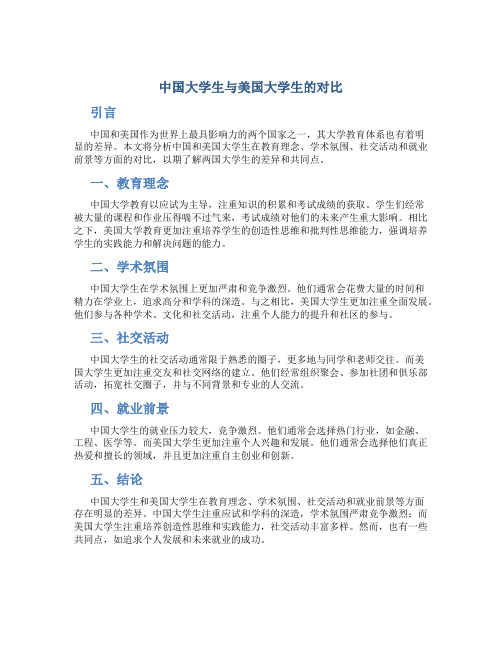
中国大学生与美国大学生的对比引言中国和美国作为世界上最具影响力的两个国家之一,其大学教育体系也有着明显的差异。
本文将分析中国和美国大学生在教育理念、学术氛围、社交活动和就业前景等方面的对比,以期了解两国大学生的差异和共同点。
一、教育理念中国大学教育以应试为主导,注重知识的积累和考试成绩的获取。
学生们经常被大量的课程和作业压得喘不过气来,考试成绩对他们的未来产生重大影响。
相比之下,美国大学教育更加注重培养学生的创造性思维和批判性思维能力,强调培养学生的实践能力和解决问题的能力。
二、学术氛围中国大学生在学术氛围上更加严肃和竞争激烈。
他们通常会花费大量的时间和精力在学业上,追求高分和学科的深造。
与之相比,美国大学生更加注重全面发展。
他们参与各种学术、文化和社交活动,注重个人能力的提升和社区的参与。
三、社交活动中国大学生的社交活动通常限于熟悉的圈子,更多地与同学和老师交往。
而美国大学生更加注重交友和社交网络的建立。
他们经常组织聚会、参加社团和俱乐部活动,拓宽社交圈子,并与不同背景和专业的人交流。
四、就业前景中国大学生的就业压力较大,竞争激烈。
他们通常会选择热门行业,如金融、工程、医学等。
而美国大学生更加注重个人兴趣和发展。
他们通常会选择他们真正热爱和擅长的领域,并且更加注重自主创业和创新。
五、结论中国大学生和美国大学生在教育理念、学术氛围、社交活动和就业前景等方面存在明显的差异。
中国大学生注重应试和学科的深造,学术氛围严肃竞争激烈;而美国大学生注重培养创造性思维和实践能力,社交活动丰富多样。
然而,也有一些共同点,如追求个人发展和未来就业的成功。
总体而言,中国和美国的大学教育各有特色,无论是中国的应试教育还是美国的综合素质教育,都希望培养出全面发展的人才。
无论是中国大学生还是美国大学生,都是年轻一代的希望,他们将引领未来社会的发展和进步。
(注:以上内容仅供参考,可以根据实际情况进行修改和扩充)。
美国学生和中国学生的区别英语作文初一
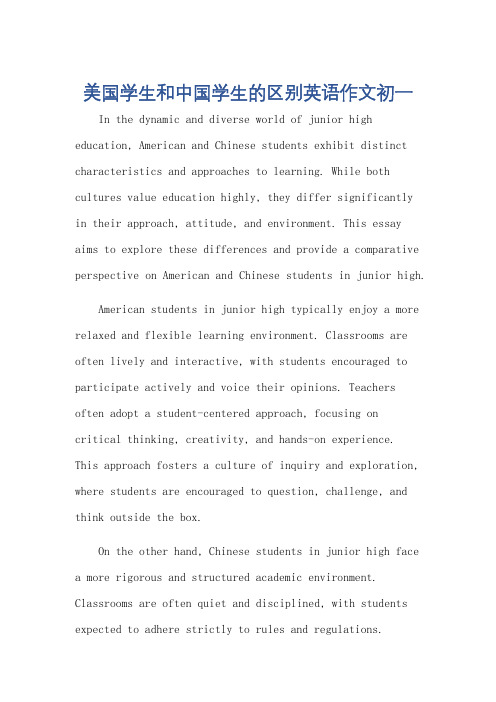
美国学生和中国学生的区别英语作文初一In the dynamic and diverse world of junior high education, American and Chinese students exhibit distinct characteristics and approaches to learning. While both cultures value education highly, they differ significantlyin their approach, attitude, and environment. This essay aims to explore these differences and provide a comparative perspective on American and Chinese students in junior high. American students in junior high typically enjoy a more relaxed and flexible learning environment. Classrooms are often lively and interactive, with students encouraged to participate actively and voice their opinions. Teachersoften adopt a student-centered approach, focusing oncritical thinking, creativity, and hands-on experience.This approach fosters a culture of inquiry and exploration, where students are encouraged to question, challenge, and think outside the box.On the other hand, Chinese students in junior high face a more rigorous and structured academic environment. Classrooms are often quiet and disciplined, with students expected to adhere strictly to rules and regulations.Teachers play a more directive role, emphasizing discipline, obedience, and respect for authority. This approach cultivates a culture of hard work, perseverance, and focus, where students are trained to excel academically andprepare for future success.In terms of extracurricular activities, American students tend to have a more diverse range of options. Sports, clubs, and community service are common activities that provide students with opportunities to develop their interests, skills, and social networks. These activitiesare often encouraged by schools and teachers, who believe that they contribute to the overall development of the student.By contrast, Chinese students often focus more on academic pursuits. While there are still extracurricular activities available, they tend to be more academic-oriented, such as math competitions or science clubs. This focus on academics is driven by the high stakes associated with educational attainment in Chinese society, where academic success is often a prerequisite for future career opportunities.In conclusion, American and Chinese students in junior high differ significantly in their approach to learning, attitude towards education, and extracurricular activities. While both cultures value education highly, they prioritize different aspects of it based on their unique cultural, social, and educational systems. Understanding these differences can help us appreciate the diverse and valuable contributions that students from different cultures can make to the global educational landscape.**美国学生和中国学生的区别:初中阶段的比较视角** 在初中教育的动态和多元化世界中,美国学生和中国学生展现出不同的特点和学习方法。
中国大学生与美国大学生的对比

在此添加您的文本16字
美国大学生
在此添加您的文本16字
美国的教育体系更加注重培养学生的创新能力和创业精神 。
在此添加您的文本16字
美国的大学生更敢于尝试和冒险,许多成功的创业公司都 是由大学生创立的。
国际视野与跨文化交流能力
中国大学生
在跨文化交流能力方面,中国大学生通过参与国际交流 项目和志愿服务等途径不断提升。
美国的教育资源与机会
美国的高等教育资源丰富,拥有世界一流的大学和研究中心。美国的教育体系注重学生的个性化发展 ,为学生提供了更多的选择和机会。同时,美国的教育体系也注重公平性,努力让更多学生能够享受 到优质的教育资源。 02学术环境与学习方式
学术氛围与压力
学术氛围
中国:学术氛围较为严谨,学生通常 面临较大的学术压力,注重考试成绩
中国大学生
生活环境:多数中国大学提供宿舍, 学生通常在校园内居住,生活设施相
对完善。
设施:中国大学注重基础设施建设, 提供图书馆、体育馆、实验室等资源 丰富的学习和生活场所。
美国大学生
生活环境:美国大学生多数选择在校 外租房或住校,校园周边生活设施完 备,更强调独立生活。
设施:美国大学注重学生个人发展和 创新教育,提供各种实验室、工作室 、艺术中心等特色设施。
社交活动:美国大学生在俱乐部和组织中更注重个人发展 和兴趣爱好,强调个性和创新。
在此添加您的文本16字
文化活动:美国大学举办多元文化节、国际日等活动,鼓 励学生了解和尊重不同文化。
就业准备与社会融入
中国大学生
社会融入:中国大学生毕业后多选择就业或继续深造, 相对较快融入社会。
就业准备:美国大学注重实践能力和创新精神的培养, 提供丰富的实习和创业机会。
美国学生和中国学生的不同英语作文
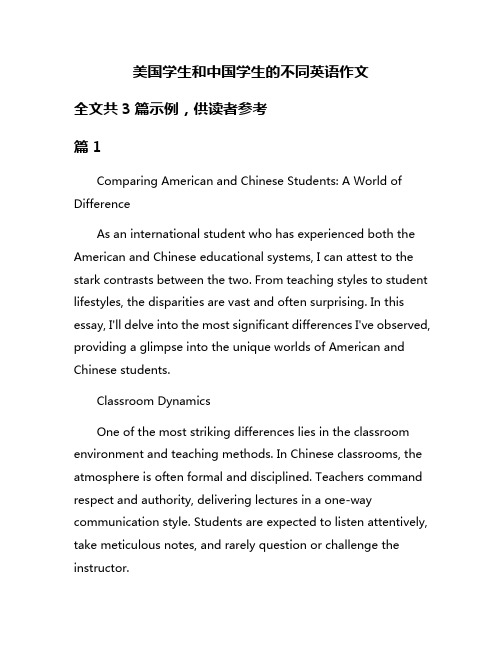
美国学生和中国学生的不同英语作文全文共3篇示例,供读者参考篇1Comparing American and Chinese Students: A World of DifferenceAs an international student who has experienced both the American and Chinese educational systems, I can attest to the stark contrasts between the two. From teaching styles to student lifestyles, the disparities are vast and often surprising. In this essay, I'll delve into the most significant differences I've observed, providing a glimpse into the unique worlds of American and Chinese students.Classroom DynamicsOne of the most striking differences lies in the classroom environment and teaching methods. In Chinese classrooms, the atmosphere is often formal and disciplined. Teachers command respect and authority, delivering lectures in a one-way communication style. Students are expected to listen attentively, take meticulous notes, and rarely question or challenge the instructor.In contrast, American classrooms foster a more interactive and participatory learning experience. Teachers encourage open discussions, debates, and the exchange of ideas. Students are encouraged to ask questions, voice their opinions, and critically analyze the material presented. This approach nurtures critical thinking skills and independent thought.Extracurricular ActivitiesAnother significant distinction lies in the realm of extracurricular activities. In China, academics are the primary focus, and students dedicate the majority of their time to studying and excelling in core subjects like math, science, and language arts. Extracurricular activities, while available, are often viewed as secondary priorities.Conversely, American schools place a strong emphasis on well-rounded development. Students are actively encouraged to participate in a wide range of extracurricular activities, including sports, clubs, volunteer work, and artistic pursuits. These activities are seen as integral to personal growth, fostering teamwork, leadership skills, and a balanced lifestyle.Parental InvolvementThe role of parents in a student's educational journey also differs significantly between the two countries. In China, parents are heavily involved in their children's academic endeavors, often exerting considerable pressure to achieve top grades and secure admission to prestigious universities. This intense parental involvement can lead to a highly competitive and stressful environment for students.In the United States, while parental support is valued, there is generally a greater emphasis on fostering independence and individuality. Students are encouraged to take ownership of their academic pursuits and make decisions that align with their personal interests and goals. Parental involvement is more balanced, allowing for students to develop self-discipline and self-motivation.Social Lives and Peer RelationshipsThe social dynamics and peer relationships among students in the two countries also exhibit stark contrasts. In China, the intense academic pressure often leaves little time for socializing and leisure activities. Students typically form close-knit study groups and rely heavily on peer support to navigate the competitive academic landscape.American students, on the other hand, tend to have a more active social life outside of academics. Friendships are often formed through shared interests, extracurricular activities, and social events. There is a greater emphasis on maintaining a balance between academics and leisure, fostering personal growth through diverse experiences and social connections.Technology and Learning ResourcesThe integration of technology and access to learning resources is another area where American and Chinese students differ. In China, traditional textbooks and classroom instruction are still the primary modes of learning. While technology is gradually being incorporated, access to online resources and digital learning platforms can be limited.American schools, however, have embraced technology wholeheartedly. Students have access to a wealth of online learning materials, interactive educational apps, and digital collaboration tools. This technological integration not only enhances the learning experience but also prepares students for the digital world they will encounter in their future careers.ConclusionIn conclusion, the differences between American and Chinese students are profound, reflecting the unique cultural, social, and educational philosophies of each country. While the Chinese system emphasizes discipline, rigor, and academic excellence, the American approach values creativity, critical thinking, and well-rounded personal development.Ultimately, both systems have their strengths and weaknesses, and understanding these differences can foster greater cross-cultural appreciation and learning. As an international student, I've gained invaluable insights from experiencing both worlds, and I believe that embracing diversity and open-mindedness is the key to becoming a truly global citizen in the 21st century.篇2Differences Between American and Chinese StudentsAs an international student who has studied in both China and the United States, I've had a unique opportunity to observe the contrasting educational systems and cultures firsthand. While there are certainly similarities, the disparities between American and Chinese students are quite striking. In this essay, I'll delve into some of the key differences I've noticed.Study Habits and Approach to LearningOne of the most apparent distinctions lies in our study habits and approach to learning. Chinese students tend to be exceptionally diligent and hardworking, often spending countless hours poring over textbooks and practice problems. We are raised with a strong emphasis on rote memorization and a reverence for academic achievement from a young age.In contrast, American students generally take a more interactive and participatory approach to learning. They are encouraged to ask questions, engage in discussions, and think critically about the material. While Chinese students may be seen as more studious, American students often excel in areas that require creativity, independent thinking, and problem-solving skills.Classroom EnvironmentThe classroom environments in the two countries also differ significantly. In China, classes tend to be large, with ateacher-centered approach where the instructor lectures, and students are expected to listen attentively and take meticulous notes. Questioning or challenging the teacher is often discouraged, as they are regarded as the ultimate authority on the subject matter.American classrooms, on the other hand, are typically smaller and more interactive. Students are expected to participate actively in class discussions, share their opinions, and engage in group projects or collaborative learning activities. Teachers act more as facilitators, encouraging students to think critically and express their ideas freely.Extracurricular ActivitiesExtracurricular activities play a vastly different role in the lives of American and Chinese students. In China, the primary focus is on academic pursuits, with little emphasis on extracurricular activities like sports, clubs, or hobbies. Students are expected to dedicate their time and energy to studying and achieving top grades.In contrast, American students are strongly encouraged to participate in extracurricular activities, which are seen as essential for their overall development. These activities not only provide opportunities for students to explore their interests and passions but also help them develop leadership skills, teamwork, and time management abilities.Parental Involvement and ExpectationsParental involvement and expectations also differ significantly between the two cultures. Chinese parents tend to be heavily involved in their children's education, often placing immense pressure on them to excel academically. They may have high expectations for their children to pursue prestigious careers in fields like medicine, law, or engineering.American parents, while still supportive of their children's education, generally allow for more autonomy and flexibility. They encourage their children to explore their interests and passions, and are often more open to non-traditional career paths or alternative educational routes.Pressure and Mental HealthThe intense academic pressure and competition in China can take a significant toll on students' mental health. The constant emphasis on high achievement and the fear of disappointing parents or falling behind their peers can lead to stress, anxiety, and even depression among Chinese students.While American students certainly face their own pressures and challenges, there is generally a greater emphasis on mental health awareness and support systems within schools and universities. Students are encouraged to seek help when needed and to maintain a healthy work-life balance.Future Outlook and Career ProspectsThe differences in educational systems and cultural values also shape the future outlook and career prospects of American and Chinese students. Chinese students often have a more focused and narrower career path in mind, driven by the desire for stability, prestige, and financial security.American students, on the other hand, may have a broader range of career aspirations and be more open to exploring different paths or even starting their own businesses. They are often encouraged to pursue their passions and to think outside traditional career paths.In conclusion, while both American and Chinese students share a common goal of pursuing education and personal growth, the ways in which we approach this journey are vastly different. From study habits and classroom environments to extracurricular activities and parental expectations, these contrasting experiences shape our perspectives, values, and future trajectories. As an international student, I've come to appreciate the strengths and challenges of both educational systems, and I believe that understanding and embracing these differences can lead to a more enriching and well-rounded educational experience for all.篇3The Contrasts Between American and Chinese Student LifeAs an international student who has experienced both the American and Chinese educational systems, I've noticed some striking differences in the approach to academics and student life. Don't get me wrong, both cultures highly value education and hard work. But the paths we walk diverge quite a bit when it comes to teaching philosophies, academic expectations, and campus cultures.Let's start with the classroom dynamic. In China, it's much more teacher-centered and lecture-based. The professor is regarded as the supreme authority and source of knowledge. Students are expected to respectfully absorb information like sponges, memorizing loads of facts and theories. Class participation is pretty minimal - you mainly just listen, take diligent notes, and don't ask too many questions that could be seen as contradicting or challenging the teacher.The American classroom, on the other hand, is a bit more casual and interactive. Professors still lead the lessons, but they encourage active student participation through discussions, debates, and even challenging their ideas. You're expected tothink critically, form your own opinions, and defend them with facts and logic. The teachers act more as facilitators, guiding you to find your own understandings.This difference extends to the broader academic expectations too. In China, emphasisisprimarilyplaced on standardized test scores that assess your grasp of the standard curriculum. Late nights of hardcore cramming and rote memorization are the norm. The attitude is more "Work harder" to excel.Meanwhile, American education values students who take a more well-rounded approach - developing analytical abilities, creative thinking, communication skills, and exploration of personal interests and passions beyond just prescribed texts. The mindset leans more toward "Work smarter, not just harder."Both systems certainly produce many talented, successful students. But the roads they take are quite different in terms of philosophy and methods.Campus life between the two countries also contrasts quite vividly. At American universities, it's a huge part of the overall experience and personal growth. There's a vibrant social scene with tons of clubs, sports, parties, protests, and the infamous "Greek life." University is seen as a time to not only build yourintellect, but to explore your identity, independence, and passions outside the classroom.In China, campus social life is much more subdued. There are clubs and activities for sure, but the main mission is bucklingsolely down on academics with extraordinary discipline and commitment. The attitude is more "No playing until the work is done." University is regarded as strictly a time for pursuing your professional training and ensuring vocational success upon graduating.Personally, I can see the pros and cons of both approaches. The American way is perhaps better for developingmulti-talented, well-rounded individuals ready for diverse challenges. But the intense Chinese method is laser-focused on academics and can produce incredibly skilled experts in specific fields.As for living situations, American students generally experience a lot more independence much earlier. At 18, they're already moving into dorms or off-campus housing without parents. They also usually have part-time jobs from high school to cover living expenses. This early autonomy promotesself-sufficiency and life skills.Most Chinese students, on the flip side, continue living at home through university. They don't tend to work while studying, so they remain fairly dependent on their families for financial support and housing. The upside is that living costs are lower, and there are fewer distractions from studies. But it also breeds a more sheltered lifestyle lacking in independence and "adult" responsibilities.When it comes to the social perception of students, I've also detected some cultural differences. In America, being a student and taking a long academic journey is generally seen as pretty normal and acceptable. Most don't face immense pressure to immediately start careers and families after teenager years.But in China, there's a bit more societal bias and haste to settle into a stable job and marriage soon after the education is complete. The patience for prolonged studying into one's late 20s or beyond isn't quite as high. The cultural mentality is more bent on checking those typical "life milestone" boxes - decent career, marriage, house, kids - sooner rather than later after university.Those are just a few of the major contrasts I've identified between the American and Chinese approaches to academics and student life. Of course, these are generalities, and plenty ofexceptions exist in both societies. Every individual's experiences and perspectives can also differ.But overall, the American system tends to be morewell-rounded yet exploratory, while the Chinese method is intensely focused yet perhaps narrower in scope. Both work hard, just in rather different ways influenced by their cultural priorities and educational philosophies.For me personally, living and studying in both countries has been an amazing opportunity to soak up the best of both worlds. I'll forever appreciate the rigorous work ethic and subject mastery instilled by my Chinese foundations. But I've also greatly valued the American emphasis on developing diversified critical thinking abilities, self-expression, and social independence.At the end of the day, I don't think there's a definitively "better" approach. Both have their impressive strengths and room for improvement. Being exposed to both differing scholastic paths has not only enriched my education, but allowed me to form a more globalized perspective that our world sorely needs more of.。
中国学生和美国学生的不同点作文

中国学生和美国学生的不同点作文《中国学生和美国学生的不同点》小朋友们,你们知道吗?中国学生和美国学生有很多不一样的地方呢!中国学生上学的时候,书包总是沉甸甸的,里面装满了各种课本和作业本。
每天都有好多作业要做,放学回家还要去上各种补习班。
但是美国学生的书包就没那么重啦,他们的作业也没有那么多。
比如说,中国学生很重视数学,会做很多很难的数学题。
美国学生在数学方面可能就没有那么厉害,但是他们很会创新,常常能想出一些新奇的点子。
中国学生在学校要穿整齐的校服,而美国学生可以穿自己喜欢的衣服。
在课堂上也不一样哦,中国学生比较安静,认真听老师讲课。
美国学生就很活跃,会积极举手发言,和老师讨论问题。
小朋友们,你们觉得中国学生和美国学生谁更好呢?其实呀,大家都有自己的优点,只要努力学习,都能变得很棒!《中国学生和美国学生的不同点》小朋友们,今天我来给你们讲讲中国学生和美国学生的不同。
中国学生早上很早就要起床去上学,有时候天还没亮呢。
而美国学生上学的时间会晚一些。
中国学生吃饭的时候,喜欢一家人围坐在一起,吃很多美味的中餐。
美国学生呢,可能会吃汉堡、披萨这些快餐。
中国学生很尊敬老师,见到老师会主动问好。
美国学生和老师的关系更像是朋友,会一起开玩笑。
还有呀,中国学生放暑假、寒假一般都会在家写作业、看书。
美国学生可能会去参加各种夏令营、户外活动。
就像我的好朋友小明,他暑假就在家里学习。
而美国的小朋友托尼,暑假就去森林里露营啦。
不管是中国学生还是美国学生,都在努力成长,是不是很有趣呀?《中国学生和美国学生的不同点》小朋友们,你们想不想知道中国学生和美国学生有啥不一样?中国学生在学校里要学很多门课,语文、数学、英语等等,每一门都要学好。
美国学生的课程选择就比较自由,可以根据自己的兴趣来选。
比如说,中国学生如果喜欢画画,可能只能在课余时间去学。
但美国学生如果喜欢画画,就可以在学校专门选画画的课。
中国学生考试的时候特别紧张,都希望能考个好成绩。
两国学生的差别初三作文500字

两国学生的差别初三作文500字
两国学生的差别初三作文500字
由于国家的历史背景不同,所以他们的生活习惯等也有巨大的差异。
拿中国和美国的学生作比较,中国的学生是娇生惯养长大的但不自由,而美国的学生是自己独立自主长大的非常自由,这长大的中国学生,会接受不了残酷的社会,而最终选择自尽,而美国的学生则大大不同,这是因为他们的教育方式不同,美国的孩子只上四节课,下午则是自由的,他们可也做些家务,或打一会工,这是对他们社会环境适应能力的历练,由于这个原因,美国的孩子才能轻而易举的适应社会这个大家庭。
中国式的教育太过死板,从而导致学生厌学,逃学。
我觉得中国在注重教育的同时也要注重学生的自由,学习文化本应是快乐的,可是却被学生们挂上了讨厌的吊牌,学习是次要的,最重要的是你适应社会的环境,如果连这个都做不到,那么何谈对祖国持续不断的做出贡献呢?
有一位名人说过,中国的孩子就像笼子里的鸟,渴望外面的世界,这句话不正是应了中国教育的本质吗?也许,有可能是我错了,中国的孩子在家长的溺爱下,拒绝自由,把自己锁在一个四四方方的空间里。
也许这不是国家的错,而是我们的错误,而改变它是几乎不可能的,因为我们“溺爱”的这个“传统”比宇宙的历史还要长久。
不应该仅仅只是国家、父母的责任,孩子们也有责任,是他们太过挑剔,以至于既想要中国式的宠爱,又想要美国式的自由,所以这件事大家都有责任,不仅仅是有责任,还有义务,改变中国式溺爱的义务。
自由式生命的根本,如果没有自由,那么与行尸走肉又有何不同?。
中美学生学习的差异比较

中美学生学习的差异比较——基于中美学生学习方式探讨摘要:正说到中美学生学习的比较,我深有感触:我们的学生缺少吃苦精神。
我们的家长和学生认为高考前是最苦的。
不少大学生经过高考的"独木桥"后,开始在大学校园里舒舒服服地等着毕业。
甚至有些家长从小就给孩子灌输这种思想,让孩子认为,所有的学习都是为了高考。
于是,高考结束,学习变得不再重要。
[1]而在美国,尤其是精英云集的大学所要付出的苦是我们想象不到的,征服学习是这些大学里每个人的口号。
由此可见,中国与美国学生在学习的各个方面存在本质性的差异。
关键词:中美学生学习方式差异本文便从中国与美国学生学习方式这一角度展开描述,进行学习差异比较。
1,美国学生学习方式美国重点在于培养学生自主创新的能力,学习方式多样化,更多的是培养一个人的自我管理能力和道德修养,更加侧重于文科,学习文科你不仅是培养你自身的文化修养也是提高自我的交际能力,在说的明白点就领袖精神,作业会比较少但是想把那作业完成还是需要一定的难度,需频繁使用网络搜索有效信息,此时培养了学生搜索信息和处理信息的能力,课外活动丰富多样的,对于运动投入的比例也比较多,在美国为健康投资是一比无形的价值,可以为你赢得更多的职位和丰厚的收入。
[2]美国学生看似轻松,他想顺利的升学拿奖学金付出的要比中国还要付出的,他们会每天都会过的很充实,明白自己的奋斗目标,他们在上小学的时候就已经明确以后要从事什么类型的工作,所以他们会得到更多的快乐。
美国的课堂更多是一种轻松的状态给学生更多的机会展示自我风格,建立自信的人格也起了不小的作用。
2,中国学生学习方式在中国所谓的素质教育下,培养的是一批又一批残次品,只是机械的学习考试的工具,没撒能力,没责任感和缺乏社会公德,随着中国人口老龄化,中国的传统美德,孝道与子女道德问题日益突出,在国外虽然子女和父母的关系很冷淡但是,在当遇到困难的时候都会有人帮助你,在路上有人突然昏到,在美国会有人给你做人工呼吸或还会有人给医院打电话,在中死到路上都没人管,是对人性的蔑视,对生命的不尊重,在全盘西化的中国,自己的东西都扔完了。
论美国学生校园生活与中国学生校园生活的不同

论美国学生校园生活与中国学生校园生活的不同一.美国学生选课的高度自由与自主美国学生选课是完全取决于自己,每个人根据自己的时间和经济情况选课。
所以,没有统一的班级。
即使必修课,你也可以自由选择修读的时间。
也就是,学生只要学分符合专业计划的要求,选课的事情就完全是学生自己做主了。
但选课自由不是没有限制的,首先,你选读的专业大纲限制了你的选课范围是有限的。
学校和有关的系科只规定某个专业的必修课程和公共基础课程,专业计划里主要为选修课。
其次,你的选课要受到最高和最低周学分数量的限制。
学校规定全日制学生(Fulltime)和半工半读学生(Parttime)每周要选的最低和最高学分。
全日制一般最低为每周16个学分;半工半读一般最低为每周6学分。
但超过了一定的上限,学生选课的费用将上浮。
也就是,在某个学分数量之内选课,学费最合算。
这样,学生的自由被有效的规定了一个范围。
其三,你的选课还有某些先决性限制,例如,没有通过大学英语2级,你就不能选修3级。
由于电脑联网操作,使得这一点做起来非常容易。
在中国,一,学习任务的完成和学业水平的衡量学生在校的主要任务是学习相应专业教学计划规定的有关课程, 每门课程规定相应的学分,考试通过后即获得课程规定的学分,学生在规定学习年限内,取得教学计划规定的各类最低学分,方能取得毕业资格.每门课程的考试成绩对应一个学分绩点,学分绩点反映学习水平的高低,毕业时所有课程的平均学分绩点大于等于2,同时符合其他有关要求时,才能获得学士学位.二,所学专业开设的课程及课程组成结构每个专业都有相应的教学计划, 教学计划中列出了该专业学生在校期间应修读的课程,课程开设的学年学期,讲授的学时数,通过后可获得的学分数及总的教学要求(教学要求指那些课程必修,那些课程必须完成选修,选修的课程多少学分等)。
二.选课的压力所有学生必须自己关心选课的时间和地点,如果不留心,你很可能错过选课机会。
更重要的是,许多好的课程还必须早点去注册,否则人数满了,你就无法选上。
美国学生与中国学生的差异

美国学生与中国学生的差异提及到美国,它是一个与中国截然不同的国家,最主要的还是文化素质教育和对儿童的文化教育理念完全不一样.先拿一节绘画课为例,在中国的绘画课上,老师通常是先画出来一副示范性的画,在让学生去临摹,把学生的思维锁定在一定的范围内,完全的用圈圈框框把学生的想法规范起来.而在美国,老师则是给予孩子们灵感,让孩子们的思维与想法飞起来,再让孩子把想的画下来,哪怕画上的东西根本不存有,他们所画的也都是最优秀的.在他们的作品之中没有好与坏之分,因为老师认为孩子活跃的思维是最宝贵的.再举一例,在中国的课堂上,老师会让同学们背很多所谓的具有文学色彩的诗,曲,词,散文等东西.而美国的课上,老师万万不会给学生强制性的灌输一些诗,词或是什么带有哲理性的东西,也不会让学生去死记硬背一些什么东西.他们的方针则是教会学生们遇到了问题后的解决方法,让学生们无论遇上什么问题都能够自己独立开辟,寻找答案.中国的教育理念永远都是在奢望学生们将一切知识都能够掌握好;而美国却永远会给孩子们想象的空间和余地,让学生有充足的时间去从各方面查阅所需要的答案和内容.以前有一位中国的留学到美国的博士,在美国整整五年都一优异的成绩取得奖学金,不过他去费解一点:"我觉得很奇怪,要是凭借着成绩而拿得奖学金,美国学生根本不是中国人的对手,不过一到实践领域,搞点研究性的题目,中国学生往往就没有没国学生那么机灵,那么富有创造性了!"这是两种不同基础的教育体系和历年所造成的人与人之间的差异.中国人太习惯与在一个计划的柜子里去施展拳脚了,且一但失去了常规的参照,对于很多中国人来说感到的可能往往不是自由,而是恐慌和茫然.一位华侨的母亲问自己孩子现今的美国老师,为什么不让孩子背或记一点重要的知识和东西呢?老师却笑者着回答说:"对人的创造水平中有两个东西比死记硬背更重要:一是学生要知道是上哪里寻找所需要的,比他能够记忆多得多的知识更重要;再一个是他的综合使用这些知识实行新的创造,死记硬背是不会让一个人变得聪明,这就是我的观点......"一个来自中国的男孩,第一天紧张的背着书包走进美国的课堂,晚上放学回家,妈妈问正在利用电脑来查找东西的孩子一天过得怎么样,他仅仅用英文说了一句:"自由."看看美国学生空荡荡的书包和轻松的学习生活,再看看中国那些课堂上双手背后坐得笔直的孩子们,想到那写沉重的课程,繁多的作业,严格的考试......让人感到一种神圣和威严的同时,也让人感到巨大的压抑和束缚,足以令人窒息,但是多少代人都顺着这种令人窒息的理念,把它视为一种改变命运的出路,一种文化的延续.它或许记载着自身的辉煌,但是,面对需要每个人发挥创造的信息社会,面对明天的世界,我们又能怎么审视这种孕育了我们自身的文明呢?。
《浅谈中美教育的差异》教育案例分析
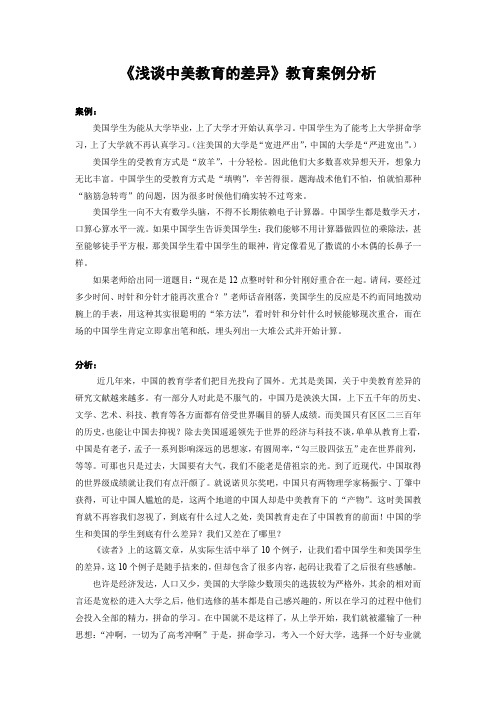
《浅谈中美教育的差异》教育案例分析案例:美国学生为能从大学毕业,上了大学才开始认真学习。
中国学生为了能考上大学拼命学习,上了大学就不再认真学习。
(注美国的大学是“宽进严出”,中国的大学是“严进宽出”。
)美国学生的受教育方式是“放羊”,十分轻松。
因此他们大多数喜欢异想天开,想象力无比丰富。
中国学生的受教育方式是“填鸭”,辛苦得很。
题海战术他们不怕,怕就怕那种“脑筋急转弯”的问题,因为很多时候他们确实转不过弯来。
美国学生一向不大有数学头脑,不得不长期依赖电子计算器。
中国学生都是数学天才,口算心算水平一流。
如果中国学生告诉美国学生:我们能够不用计算器做四位的乘除法,甚至能够徒手平方根,那美国学生看中国学生的眼神,肯定像看见了撒谎的小木偶的长鼻子一样。
如果老师给出同一道题目:“现在是12点整时针和分针刚好重合在一起。
请问,要经过多少时间、时针和分针才能再次重合?”老师话音刚落,美国学生的反应是不约而同地拨动腕上的手表,用这种其实很聪明的“笨方法”,看时针和分针什么时候能够现次重合,而在场的中国学生肯定立即拿出笔和纸,埋头列出一大堆公式并开始计算。
分析:近几年来,中国的教育学者们把目光投向了国外。
尤其是美国,关于中美教育差异的研究文献越来越多。
有一部分人对此是不服气的,中国乃是泱泱大国,上下五千年的历史、文学、艺术、科技、教育等各方面都有倍受世界瞩目的骄人成绩。
而美国只有区区二三百年的历史,也能让中国去抑视?除去美国遥遥领先于世界的经济与科技不谈,单单从教育上看,中国是有老子,孟子一系列影响深远的思想家,有圆周率,“勾三股四弦五”走在世界前列,等等。
可那也只是过去,大国要有大气,我们不能老是借祖宗的光。
到了近现代,中国取得的世界级成绩就让我们有点汗颜了。
就说诺贝尔奖吧,中国只有两物理学家杨振宁、丁肇中获得,可让中国人尴尬的是,这两个地道的中国人却是中美教育下的“产物”。
这时美国教育就不再容我们忽视了,到底有什么过人之处,美国教育走在了中国教育的前面!中国的学生和美国的学生到底有什么差异?我们又差在了哪里?《读者》上的这篇文章,从实际生活中举了10个例子,让我们看中国学生和美国学生的差异,这10个例子是随手拈来的,但却包含了很多内容,起码让我看了之后很有些感触。
中国学生和美国学生的差异用英语写一篇作文
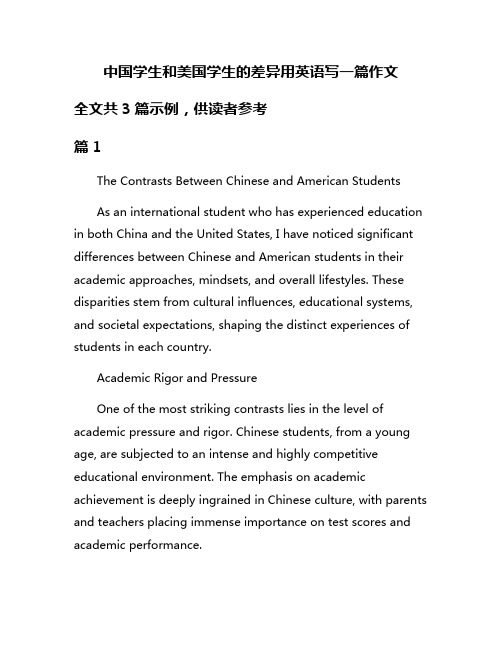
中国学生和美国学生的差异用英语写一篇作文全文共3篇示例,供读者参考篇1The Contrasts Between Chinese and American StudentsAs an international student who has experienced education in both China and the United States, I have noticed significant differences between Chinese and American students in their academic approaches, mindsets, and overall lifestyles. These disparities stem from cultural influences, educational systems, and societal expectations, shaping the distinct experiences of students in each country.Academic Rigor and PressureOne of the most striking contrasts lies in the level of academic pressure and rigor. Chinese students, from a young age, are subjected to an intense and highly competitive educational environment. The emphasis on academic achievement is deeply ingrained in Chinese culture, with parents and teachers placing immense importance on test scores and academic performance.In China, the notorious "gaokao" (College Entrance Examination) is a make-or-break event that determines a student's future prospects. The pressure to excel in this exam is overwhelming, leading many Chinese students to endure grueling study schedules and immense stress. Extracurricular activities or personal interests often take a backseat to academic pursuits.On the other hand, American students generally experience a more balanced approach to education. While academic performance is still valued, there is a greater emphasis onwell-rounded development, including extracurricular activities, social skills, and personal growth. The pressure to achieve top grades is present but often not as intense as in China.Learning Styles and Classroom DynamicsThe learning styles and classroom dynamics in China and the United States also differ significantly. Chinese classrooms tend to be more teacher-centered, with a focus on rote learning, memorization, and lecture-based instruction. Students are expected to be passive recipients of knowledge, diligently taking notes and absorbing information.In contrast, American classrooms promote a more interactive and participatory learning environment. Students areencouraged to ask questions, engage in discussions, and express their opinions. Critical thinking, problem-solving, and collaborative learning are highly valued. Teachers act more as facilitators, guiding students through the learning process rather than simply imparting knowledge.Extracurricular Activities and Social LifeThe role of extracurricular activities and social life in the lives of Chinese and American students also differs considerably. In China, the primary focus is on academic pursuits, with extracurricular activities often taking a backseat. Chinese students may participate in a few structured activities, such as music lessons or sports clubs, but these are typically seen as supplementary to their studies.In the United States, however, extracurricular activities are an integral part of the student experience. American students are encouraged to participate in a wide range of activities, from sports teams and clubs to volunteering and community service. These activities are valued not only for their social and personal development benefits but also for their potential to enhance college applications.American students also tend to have a more active social life, with a greater emphasis on socializing, dating, and partying.While Chinese students do engage in social activities, the intensity and frequency are generally lower due to the academic demands and cultural expectations.Parental Involvement and ExpectationsParental involvement and expectations also play a significant role in shaping the experiences of Chinese and American students. In Chinese culture, parents are heavily involved in their children's education, often pushing them to excel academically from a young age. There is a strong emphasis on bringing honor and pride to the family through academic achievement.American parents, while supportive of their children's education, tend to be more hands-off and encourage independence and self-discovery. They may provide guidance and resources but typically allow their children more autonomy in their academic and personal decisions.Future Prospects and Career PathsThe differing academic experiences and cultural expectations of Chinese and American students often influence their future prospects and career paths. In China, the highly competitive educational system and emphasis on academic achievement often lead students to pursue traditional,prestigious careers such as medicine, engineering, or civil service.American students, on the other hand, have a broader range of career options and are encouraged to explore their passions and interests. While some may follow traditional paths, others may pursue unconventional or entrepreneurial ventures, driven by their individual goals and aspirations.ConclusionIn conclusion, the differences between Chinese and American students are profound and multifaceted, rooted in cultural, educational, and societal factors. Chinese students face intense academic pressure and a highly competitive environment, with a focus on rote learning and exam performance. American students, while still valuing academic achievement, experience a more balanced approach, with greater emphasis on extracurricular activities, social life, and personal growth.These contrasting experiences shape the mindsets, priorities, and future trajectories of students in each country. While both systems have their strengths and weaknesses, understanding these differences can foster cross-cultural understanding andappreciation for the diverse educational journeys of students worldwide.篇2The Contrast Between Chinese and American StudentsAs an international student who has experienced both the Chinese and American education systems, I have noticed significant differences in the approaches and mindsets of students from these two countries. While generalizations should be made cautiously, there are distinct cultural and societal influences that shape the learning habits and attitudes of Chinese and American pupils.One of the most striking contrasts lies in the perception of academic achievement. For Chinese students, academic excellence is often viewed as a paramount pursuit, deeply ingrained from a young age. Education is regarded as a sacred pathway to success, and parents instill a deep-rooted reverence for educational attainment in their children. From an early age, Chinese pupils are conditioned to view academic performance as a reflection of their worth and a determinant of their future prospects.This emphasis on academic achievement manifests itself in the study habits of Chinese students. They are known for their diligence, resilience, and unwavering dedication to their studies. Long hours of intense studying, memorization, and practice are the norm. Chinese students are taught to prioritize discipline and perseverance over innate talent or intelligence. The notion of "hard work triumphs over natural ability" is deeply ingrained in the Chinese educational philosophy.In contrast, the American approach to education often places a greater emphasis on well-rounded development, critical thinking, and personal growth. While academic achievement is certainly valued, there is a more balanced perspective on its significance. American students are encouraged to explore their interests, participate in extracurricular activities, and develop social skills alongside their academic pursuits.The classroom dynamics in American and Chinese educational settings also differ substantially. In Chinese classrooms, the teaching style is often more teacher-centered, with a focus on lecture-based instruction and rote memorization. Students are expected to listen attentively, take meticulous notes, and follow the teacher's lead. Questioning or challenging theteacher's authority is generally discouraged, as respect for elders and hierarchy is deeply embedded in Chinese culture.Conversely, American classrooms tend to foster a more interactive and participatory learning environment. Students are encouraged to ask questions, engage in discussions, and express their opinions. Critical thinking and independent reasoning are highly valued, and teachers often act as facilitators, guiding students toward discovering knowledge rather than merely imparting information.The approach to testing and assessment also varies between the two educational systems. Chinese students are accustomed to high-stakes, standardized exams that carry immense weight in determining their academic futures. The pressure to excel in these exams is immense, and students often undergo rigorous preparation and coaching to maximize their scores.In contrast, American assessments tend to be more diverse, incorporating project-based learning, presentations, and continuous evaluation throughout the academic year. While standardized tests are still significant, there is a greater emphasis on assessing a student's overall learning process and skill development rather than solely relying on a single, high-stakes examination.Despite these differences, both Chinese and American students share a common desire for knowledge and personal growth. However, the paths they take to achieve these goals are shaped by their respective cultural and societal influences.It is crucial to recognize that these contrasts are not absolute, and there are exceptions within each educational system. Additionally, as the world becomes increasingly interconnected, there is a growing recognition of the strengths and limitations of both approaches, leading to cross-cultural exchange and adaptation.Ultimately, the differences between Chinese and American students reflect the diverse values and priorities embedded within their respective societies. By understanding and appreciating these contrasts, we can foster mutual respect, learn from one another's strengths, and work towards creating educational environments that nurture the unique talents and aspirations of all students.篇3The Stark Contrast: Chinese Students vs American StudentsAs an international student who has experienced both the Chinese and American education systems, I can't help but noticethe striking differences between students from these two vastly different cultures. From work ethics to social lives, the contrasts are profound and often surprising. In this essay, I will delve into the key distinctions that define the academic journeys and overall lifestyles of Chinese and American students.Work Ethic and Academic PressureOne of the most glaring disparities lies in the realm of work ethic and academic pressure. Chinese students, from a very young age, are instilled with a deep-rooted belief in the importance of education and academic excellence. This cultural emphasis on education stems from the Confucian values that have shaped Chinese society for centuries. Academic success is not merely a personal goal but a familial and societal expectation.From the moment they enter the education system, Chinese students are bombarded with a relentless stream of homework, tests, and extracurricular activities. The pressure to excel is immense, and the competition is fierce. Students often spend countless hours studying, sometimes well into the night, driven by the fear of falling behind their peers.In contrast, American students generally experience a more relaxed academic environment. While education is certainlyvalued, the pressure to achieve top grades is often not as intense. American students are encouraged to explore their interests, participate in various extracurricular activities, and maintain a balanced lifestyle. The focus is not solely on academic prowess but on developing well-rounded individuals.Social Lives and Extracurricular ActivitiesThe social lives and extracurricular activities of Chinese and American students also differ substantially. For Chinese students, the emphasis on academic achievement often leaves little room for a vibrant social life or indulgence in hobbies and interests outside of academics. Their schedules are typically packed with tutoring sessions, cram schools, and endless hours of study.Conversely, American students tend to have a more active social life and engage in a wide range of extracurricular activities. From sports teams to clubs and organizations, American students are encouraged to pursue their passions and interests beyond the classroom. This emphasis on extracurricular activities is often seen as an essential part of their overall development and a way to build character, leadership skills, and awell-rounded resume for college applications.Classroom Dynamics and Teaching StylesThe classroom dynamics and teaching styles in Chinese and American schools also exhibit notable differences. In Chinese classrooms, the teaching approach is often more traditional and teacher-centered. Students are expected to be passive recipients of knowledge, diligently taking notes and memorizing information. Class participation and open discussions are generally discouraged, as respect for authority and obedience to the teacher are deeply ingrained values.On the other hand, American classrooms tend to be more interactive and student-centered. Teachers encourage open discussions, critical thinking, and the expression of individual opinions. Students are encouraged to ask questions, challenge ideas, and engage in lively debates. This approach fosters creativity, problem-solving skills, and the ability to think independently.Parental Involvement and ExpectationsParental involvement and expectations also play a significant role in shaping the experiences of Chinese and American students. Chinese parents often have exceedingly high expectations for their children's academic performance. They are heavily involved in their children's education, closely monitoringtheir progress and providing constant guidance and pressure to succeed.In contrast, American parents generally take a morehands-off approach, allowing their children to explore their interests and make their own choices. While supportive, they often place less emphasis on academic achievement as the sole measure of success. American parents are more likely to encourage their children to pursue their passions and find their own paths in life.Future Prospects and Career ChoicesThe differences in academic experiences and societal expectations also influence the future prospects and career choices of Chinese and American students. For many Chinese students, the ultimate goal is to secure a prestigious and financially stable career, often in fields like medicine, engineering, or finance. The pressure to choose a "safe" and socially respected career path is immense.In contrast, American students tend to have more freedom in choosing their career paths. While some may opt for traditional professions, others may pursue more unconventional or creative careers. The emphasis is often on finding a career thataligns with their passions and personal fulfillment, rather than solely focusing on societal expectations or financial stability.ConclusionWhile sweeping generalizations should be avoided, the contrasts between Chinese and American students are undeniable. From work ethics and academic pressure to social lives, classroom dynamics, and future prospects, these two groups of students navigate vastly different educational and cultural landscapes.Chinese students often face immense pressure to excel academically, with little room for extracurricular activities or personal interests. Their educational journey is heavily structured and focused on memorization and obedience to authority. In contrast, American students experience a more balanced approach, with opportunities to explore their passions, engage in open discussions, and develop critical thinking skills.These differences are deeply rooted in the cultural values and societal expectations of each nation. While neither system is inherently superior, understanding these contrasts can foster greater appreciation for diverse educational experiences and the unique challenges and opportunities faced by students from different backgrounds.As an international student, navigating these differences has been both eye-opening and enriching. It has taught me the importance of cultural sensitivity, open-mindedness, and the recognition that there are multiple paths to success and personal fulfillment. Ultimately, bridging these gaps and learning from one another's strengths can pave the way for a more harmonious and inclusive global community.。
中美两国教育的十个最大差异

中美两国教育的十个最大差异一、为谁而学:美国教育告诉学生学习是自己的事,让学生自己去想,想学什么东西,因而学生一般学得主动、灵活、高兴。
而中国的教育总是要事先给学生做出细致繁琐的各种规定,该学什么,学多少,什么时候学,该怎么学等等,中国的学生视学习为功利,因而习惯于应付,学习是家长、老师的事情,是为升官发财找工作而学,学得被动、教条、无奈。
二、育人目标:美国不太重视“基础知识”的学习,极其看重学生“创造力”的培养,因而才会有美国白领不会算10减6等于几貌似“可笑”的事情发生,他们觉得要趁孩子年龄小时抓紧培养创造性思维,而中国教育特别重视所谓的“双基”,重在练“基本功”,不重视对学生创造力和思维能力的培养。
美国的学生低分高能,中国的学生高分低能。
因而世界500强企业,一般不愿意接收中国学生,在他们看来,中国教育是培养知识的奴仆,而不是在“育人”。
三、课堂:中国的教育善于给孩子一个总结,把学生教到无问题就好;美国的教育善于给孩子一个启发,把学生教到能不断提出新问题。
中国的课堂要举手发言,美国的课堂鼓励自由发言。
中国的课堂如果对教师的结论不同意会遭受批评,而在美国的课堂上则受到表扬。
中国的课堂讲纪律,美国的课堂讲人权。
四、师生关系:在中国,一日为师终身为父,孩子刚踏入学校就知道老师总是高高在上,而在美国教授也没有什么权威可谈的。
美国人不承认权威。
中国孩子盲目崇拜老师,觉得老师总是对的,中国的老师喜欢保持威严,不苟言笑,美国老师很喜欢和小孩一起聊天,是要好的朋友关系。
五、考试制度:美国的考试经常是开卷,孩子们一周内交卷即可,而中国的考试则如临大敌,单人单桌,主监副监严防紧守。
在中国,考试的主要目的是为了淘汰;而美国的考试目的在于寻找自身存在的不足,查漏补缺,以利于今后的发展。
六、班级人数:中国虽明文规定每班不超过45人,但乡镇及县级学校班级人数平均60人之多,法律并不能约束什么。
而在美国,一个班的人数不超过30人,31个人就属于违反教育法,不同的是美国人看重的是诚信——自我信誉度,故不敢越雷池半步。
中国学生和美国学生的差异用英语写一篇作文
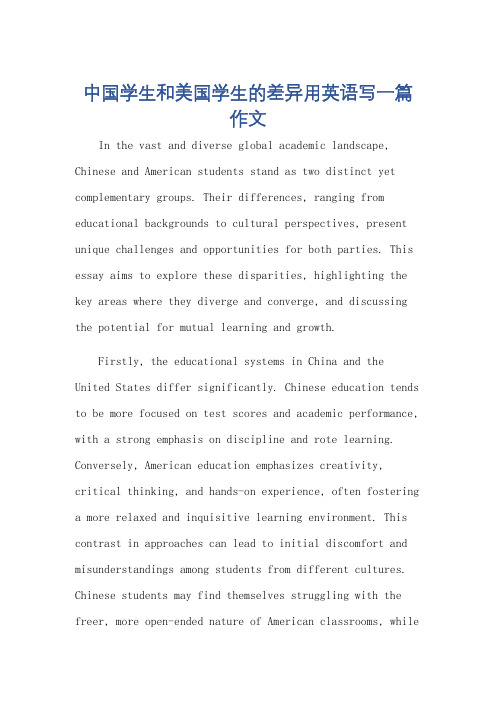
中国学生和美国学生的差异用英语写一篇作文In the vast and diverse global academic landscape, Chinese and American students stand as two distinct yet complementary groups. Their differences, ranging from educational backgrounds to cultural perspectives, present unique challenges and opportunities for both parties. This essay aims to explore these disparities, highlighting the key areas where they diverge and converge, and discussing the potential for mutual learning and growth.Firstly, the educational systems in China and the United States differ significantly. Chinese education tends to be more focused on test scores and academic performance, with a strong emphasis on discipline and rote learning. Conversely, American education emphasizes creativity, critical thinking, and hands-on experience, often fostering a more relaxed and inquisitive learning environment. This contrast in approaches can lead to initial discomfort and misunderstandings among students from different cultures. Chinese students may find themselves struggling with the freer, more open-ended nature of American classrooms, whileAmerican students may feel overwhelmed by the rigorous academic demands and strict discipline in Chinese schools.However, these differences also present valuable opportunities for growth. Chinese students can learn to embrace a more flexible, inquiry-based approach to learning, allowing them to develop their creative and analytical skills. Similarly, American students can benefit from adopting a more disciplined and focused study habit, which can help them excel in academic environments that require rigorous preparation.Cultural perspectives also play a crucial role in the differences between Chinese and American students. Chinese culture tends to emphasize collectivism, respect for authority, and conformity to social norms. In contrast, American culture values individualism, freedom of expression, and independence. These distinct cultural orientations can lead to varying communication styles and social interactions among students from the two cultures.For example, Chinese students may be more likely todefer to authority and prioritize harmony in group settings, while American students may be more outspoken and assertivein expressing their opinions. Such differences can create misunderstandings and tension if not properly navigated. However, by understanding and respecting each other's cultural backgrounds, students can learn to communicate more effectively and build stronger cross-cultural relationships.Moreover, the social and family backgrounds of Chinese and American students often shape their academic experiences. Chinese students often face significant pressure from their families and society to excel academically, which can lead to high levels of stress and anxiety. Conversely, American students may enjoy more autonomy and freedom in choosing their academic and career paths. This contrast highlights the importance of providing support and understanding to students from different cultures, as they navigate the unique challenges and opportunities presented by their respective social environments.In conclusion, the differences between Chinese and American students are numerous and diverse, ranging from educational systems to cultural perspectives. However,these differences also represent valuable resources for mutual learning and growth. By embracing these disparities and fostering a culture of understanding and respect, students from both cultures can expand their horizons, develop their skills, and contribute to a more inclusive and interconnected global academic community.**挑战与机遇:中国学生与美国学生之间的文化鸿沟** 在全球广阔的学术领域中,中国学生和美国学生作为两个独特而又互补的群体,他们的差异从教育背景到文化观念都呈现出独特的挑战和机遇。
中美学生课堂差异
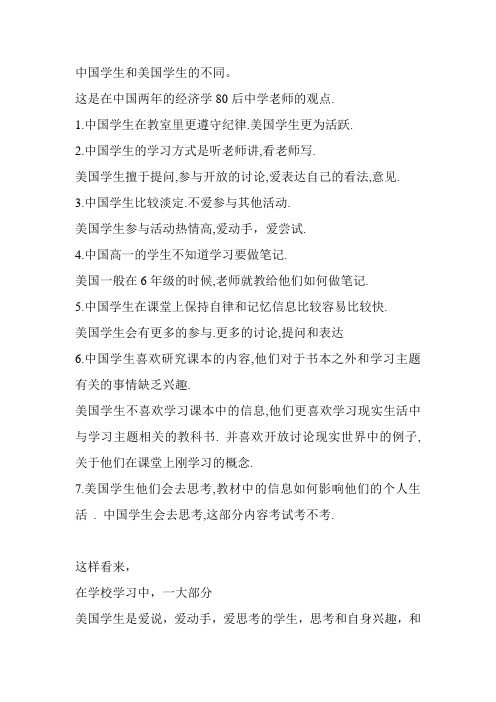
中国学生和美国学生的不同。
这是在中国两年的经济学80后中学老师的观点.1.中国学生在教室里更遵守纪律.美国学生更为活跃.2.中国学生的学习方式是听老师讲,看老师写.美国学生擅于提问,参与开放的讨论,爱表达自己的看法,意见. 3.中国学生比较淡定.不爱参与其他活动.美国学生参与活动热情高,爱动手,爱尝试.4.中国高一的学生不知道学习要做笔记.美国一般在6年级的时候,老师就教给他们如何做笔记.5.中国学生在课堂上保持自律和记忆信息比较容易比较快.美国学生会有更多的参与.更多的讨论,提问和表达6.中国学生喜欢研究课本的内容,他们对于书本之外和学习主题有关的事情缺乏兴趣.美国学生不喜欢学习课本中的信息,他们更喜欢学习现实生活中与学习主题相关的教科书. 并喜欢开放讨论现实世界中的例子,关于他们在课堂上刚学习的概念.7.美国学生他们会去思考,教材中的信息如何影响他们的个人生活. 中国学生会去思考,这部分内容考试考不考.这样看来,在学校学习中,一大部分美国学生是爱说,爱动手,爱思考的学生,思考和自身兴趣,和现实生活有关的问题。
中国学生爱看老师写,爱听老师讲。
专注于和高考相关的事情。
这样看来,美国学生关注点在自己,在自己的生活方面。
中国学生关注点在成绩,在为未来努力方面。
美国学生是即时享受生活型。
中国学生是努力奋斗再能享受生活型。
记得,清华大学一个大三女生说,她一直在寻找生活的意义,后来发现,生活本身就是意义。
每一种方式,都是一种选择。
孰好孰孬,在旁人看来是一种情况,在自己看来又是一种情况。
什么样的教育下,都有这样或者那样的结果。
存在即是合理。
哪个可以获得更多个人快乐,可以贡献更多力量给社会,可以更好的爱人类,哪个就是适合我们的自己的方式吧。
中国学生和美国学生差距到底在哪里

中国学生和美国学生差距到底在哪里我推荐大家阅读下面一份报道:“中美顶尖高中生对比是如此结果”。
央视的10频道2005年做过一期节目“碰撞”,我女儿和北京当年高考状元的面对面价值碰撞,当时在场的观众非常投入,有人指责考入北大的这位状元生自私时,我女儿说:你们不能要求北大学生是道德模范。
美国总统奖的选拔标准跟北大选拔标准不同,要求不仅学习好、还得有社会责任感、做过很多社会义工(碰巧我女儿2003年参加了这个评选)。
其实、哈佛、耶鲁等美国名校也跟北大的选拔标准不一样,成绩只占录取标准的三分之一。
因为哈佛、耶鲁培养目标是“a fine hum an being"。
那么,哈佛学生的学习是否不拔尖呢?其实哈佛本科生多数是所在高中学术第一名得主、上大学前修完了一些大学课程。
哈佛丘成桐教授谈到;"比如数学系的本科生,一年级就会根据学生情况划分不同水平,选择最好的学生去重点培养,当本科生毕业的时候,一般就会有2到3个毕业生的学术论文可以登载在第一流的杂志上。
论文水平比北京大学的教授还好。
”读完下面的报道可以思考一下:1)哪一种人才是中国需要的;2)中国教育需要怎么样调整?在拷问我们的高中毕业生时,请先拷问做父母的我们:我们又是什么样价值观的人?请再拷问一下我们的中学老师:我们这些老师是什么样价值观的人?请再拷问一下我们的社会:我们追捧什么样价值观的人?请再拷问一下我们教育和文化的精英分子们,我们是什么价值观的人?有什么样的父母、有什么样的老师、有什么样的社会、有什么样的文化榜样,就有什么样的下一代。
先修补我们这些破罐,别老骂下一代!中美顶尖高中生对比前不久,中央电视台「对话」节目邀请中美两国即将进入大学的高中生参与。
其中,美国的12名高中生都是今年美国总统奖的获得者,国内的高中生也是被北京大学、清华大学、香港大学等着名大学录取的优秀学生。
整个节目中的两个环节因为中美学生表现的强烈对比,令人震撼。
美国学生和中国学生的差异_高一作文
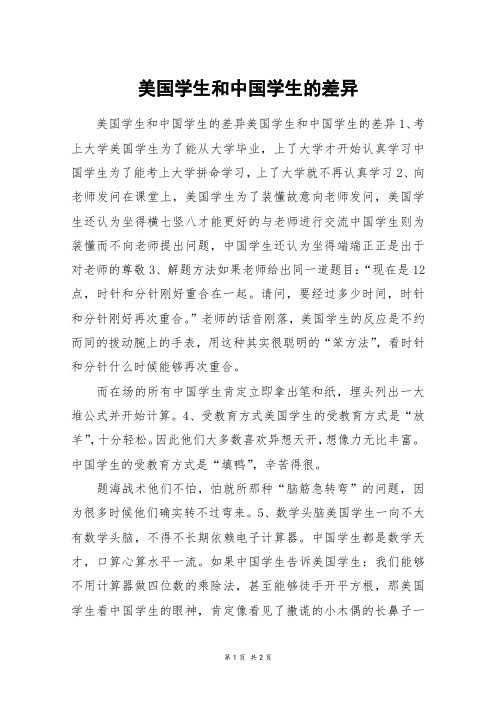
美国学生和中国学生的差异美国学生和中国学生的差异美国学生和中国学生的差异1、考上大学美国学生为了能从大学毕业,上了大学才开始认真学习中国学生为了能考上大学拼命学习,上了大学就不再认真学习2、向老师发问在课堂上,美国学生为了装懂故意向老师发问,美国学生还认为坐得横七竖八才能更好的与老师进行交流中国学生则为装懂而不向老师提出问题,中国学生还认为坐得端端正正是出于对老师的尊敬3、解题方法如果老师给出同一道题目:“现在是12点,时针和分针刚好重合在一起。
请问,要经过多少时间,时针和分针刚好再次重合。
”老师的话音刚落,美国学生的反应是不约而同的拨动腕上的手表,用这种其实很聪明的“笨方法”,看时针和分针什么时候能够再次重合。
而在场的所有中国学生肯定立即拿出笔和纸,埋头列出一大堆公式并开始计算。
4、受教育方式美国学生的受教育方式是“放羊”,十分轻松。
因此他们大多数喜欢异想天开,想像力无比丰富。
中国学生的受教育方式是“填鸭”,辛苦得很。
题海战术他们不怕,怕就所那种“脑筋急转弯”的问题,因为很多时候他们确实转不过弯来。
5、数学头脑美国学生一向不大有数学头脑,不得不长期依赖电子计算器。
中国学生都是数学天才,口算心算水平一流。
如果中国学生告诉美国学生:我们能够不用计算器做四位数的乘除法,甚至能够徒手开平方根,那美国学生看中国学生的眼神,肯定像看见了撒谎的小木偶的长鼻子一样。
6、零用钱美国学生的父母说:“我们不得不通知你,你这个月的零用钱已经走超出预算了,去,把车库打扫一下,把游泳池刷一下或者把花园里的草割了,我们就可以再给你一些钱花。
中国学生的父母说:“零用钱用完了吗?没钱了就自己到书房的抽屉里去取。
”7、旅游美国学生对自己的父母说:“我已经攒够钱了,我要去旅游了。
”中国学生对自己的父母说:“我要去旅游了,请你给我一笔钱。
”8、女朋友美国学生把女孩子带回家,自豪地对父母说:“这是我的女朋友。
”中国学生面对拿着自己已经被撬锁的日记本的气急败坏的父母,心虚地说:“我没有早恋。
美国学生和中国学生的区别英语作文
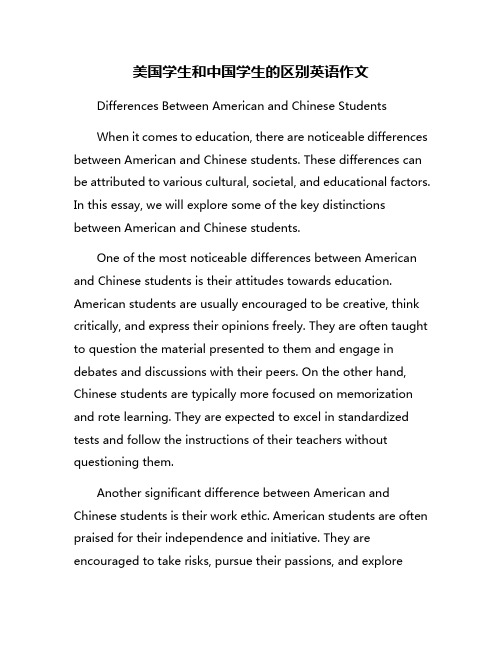
美国学生和中国学生的区别英语作文Differences Between American and Chinese StudentsWhen it comes to education, there are noticeable differences between American and Chinese students. These differences can be attributed to various cultural, societal, and educational factors. In this essay, we will explore some of the key distinctions between American and Chinese students.One of the most noticeable differences between American and Chinese students is their attitudes towards education. American students are usually encouraged to be creative, think critically, and express their opinions freely. They are often taught to question the material presented to them and engage in debates and discussions with their peers. On the other hand, Chinese students are typically more focused on memorization and rote learning. They are expected to excel in standardized tests and follow the instructions of their teachers without questioning them.Another significant difference between American and Chinese students is their work ethic. American students are often praised for their independence and initiative. They are encouraged to take risks, pursue their passions, and exploredifferent fields of study. Chinese students, on the other hand, are known for their discipline and diligence. They are expected to work hard, follow a strict study schedule, and prioritize academic success above everything else.In terms of social skills, American students tend to be more outgoing and expressive. They are encouraged to participate in extracurricular activities, build strong relationships with their peers, and develop their communication skills. Chinese students, on the other hand, are often more reserved and introverted. They are typically focused on their studies and may prioritize academic achievements over social interactions.Additionally, the grading system in the United States and China differs significantly. In the United States, students are often graded on a holistic scale that takes into account various factors such as class participation, homework assignments, projects, and exams. In China, however, students are primarily evaluated based on their performance on standardized tests, such as the Gaokao. This can create a high-pressure environment for Chinese students, as their entire future may depend on the results of a single exam.Furthermore, the role of parents in the education of American and Chinese students is also markedly different. In theUnited States, parents are often encouraged to support and guide their children, but not to dictate their educational path. American students are encouraged to make their own choices, pursue their interests, and learn from their mistakes. In China, however, parents often play a more authoritarian role in their children's education. They may dictate their study schedules, choose their extracurricular activities, and exert strong pressure on them to succeed academically.In conclusion, while there are significant differences between American and Chinese students in terms of their attitudes towards education, work ethic, social skills, grading system, and parental involvement, it is important to recognize that both educational systems have their strengths and weaknesses. By understanding and appreciating the cultural and societal factors that shape the educational experiences of American and Chinese students, we can work towards creating more inclusive and effective learning environments for all students.。
- 1、下载文档前请自行甄别文档内容的完整性,平台不提供额外的编辑、内容补充、找答案等附加服务。
- 2、"仅部分预览"的文档,不可在线预览部分如存在完整性等问题,可反馈申请退款(可完整预览的文档不适用该条件!)。
- 3、如文档侵犯您的权益,请联系客服反馈,我们会尽快为您处理(人工客服工作时间:9:00-18:30)。
美国学生和中国学生的差异
1.考上大学美国学生为了能从大学毕业,上了大学才开始认真学习。
中国学生为了能考上大学拼命学习,上了大学就不再认真学习。
(注:美国的大学是“宽进严出”,中国的大学是“严进宽出”。
)
2.向老师发问
在课堂上,美国学生为了装懂故意向老师发问,美国学生还认为坐得横七竖八才能更好地与老师进行交流。
中国学生则为装懂而不向老师提出问题,中国学生还认为坐得端端正正是出于对老师的尊敬。
3.解决方法如果老师给出同一道问题:“现在是12点整,时针和分针刚好重合在一起。
请问,要经过多少时间,时针和分针才能再次重合?”老师的话音刚落,美国学生的反应是不约而同地拨动腕上的手表,用这种其实很聪明的“笨方法”,看时针和分针什么时候能够再次重合。
而在场的所有中国学生肯定立即拿出笔和纸,埋头列出一大堆公式并开始计算。
4.受教育方式
美国学生受教育方式是“放羊”,十分轻松。
因此他们大多数喜欢异想天开,想象力无比丰富。
中国学生受教育方式是“填鸭”,辛苦得很。
题海战术他们不怕,怕就怕那种“脑筋急转弯”的问题,因为很多时候他们确实转不过弯来。
5.数学头脑美国学生一向不大有数学头脑,不得不长期依赖电子计算器。
中国学生都是数学
天才,口算心算水平一流。
如果中国学生告诉美国学生:我们都能够不用计算器做四位数的乘除法,甚至能够徒手开平方根,那美国学生看中国学生的眼神,肯定像看见了撒谎的小木
偶的长鼻子一样。
6.零用钱美国学生的父母说:“我们不得不通知你,你这个月的零用钱已经超出预算了!去,把车库打扫一下,把游泳池刷一刷或者把花园里的草割了,我们就可以再给你一些钱话。
”中国学生的父母说:“零花钱用完了吗?没钱了就自己到书房的抽屉里去取。
”
7.旅游美国学生对自己的父母说:“我已经攒够钱了,我要去旅游了!”中国学生对自己的
父母说:“我要去旅游了,请你给我一笔钱。
”
8.女朋友美国学生把女孩子带回家,自豪地对父母说:“这是我的女朋友!”中国学生面对着自己已经被撬锁的日记本的气急败坏的父母,心虚地说:“我没有早恋……”
9.新赛车美国学生喜欢夸耀自己:“瞧,这辆新赛车是我自己组装的!”中国学生则喜欢夸耀自己的长辈:“看!这是我爸爸给我买的新赛车!”
10.自己做主美国学生的父母对他们说:“亲爱的,你已经张成一个男子汉了,自己的事情应该自己做主了!不要老是依赖我们给你提供意见。
”中国学生的父母对他们吼道:“放肆!翅膀硬了是不是?敢把我们的话当耳边风?告诉你,就算你长出了胡子,你还是我们的儿子!还是得听我们的!”。
